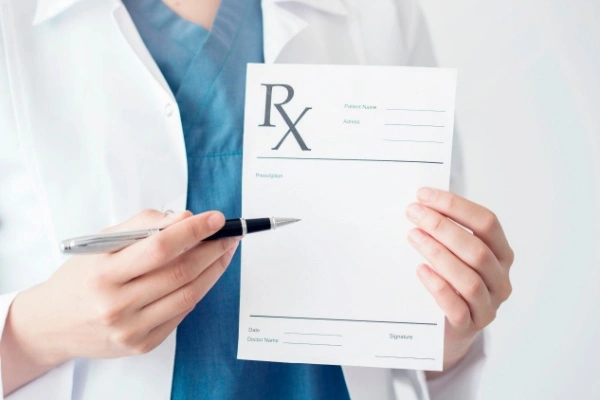Why does Canadian pharmacy require a prescription?
|
Reading time: 7 minutes
|

Key Takeaways
- A medical prescription is a formal written order issued by a licensed healthcare professional, authorizing a pharmacist to dispense a specific medication to a particular patient.
- Key components of a prescription include the date, patient and prescriber information, medication name, strength, dosage form, quantity, instructions (Sig), refills, and any warnings or special instructions, ensuring personalized and safe treatment.
- Understanding and properly managing prescriptions, including recognizing the differences between generic and brand-name medications, safely disposing of unused medication, and being aware of potential prescription errors, is crucial for maintaining health and safety.
A medical prescription (often abbreviated as Rx) is a formal written order issued by a licensed healthcare professional, such as a physician, nurse practitioner, or dentist. This order authorizes a pharmacist to dispense a specific medication to a particular patient.
Prescription medications require a doctor’s authorization due to their potential risks, potential for misuse, and complexity of use. Doctors can assess individual needs, monitor usage, and adjust dosages to ensure safety and effectiveness. On the other hand, OTC drugs are deemed safe for most people to self-treat minor ailments without direct medical supervision, as they have a lower risk profile and simpler instructions for use.
Both US and Canadian pharmacies are required by law to dispense prescription medications only with a valid prescription from a licensed healthcare provider. This is to protect patients from taking medications that are not suitable for them.
By requiring a prescription, Canadian pharmacies ensure that a qualified healthcare professional has prescribed the medication you receive and is from a reputable source. This helps to guarantee the quality and safety of the medication.
Key Components
A valid prescription typically includes:
- Date: The date the prescription was issued. This is important for tracking refills and the validity of the prescription.
- Patient Information: Your full name, address, and birth date.
- Prescriber Information: Your doctor’s name, contact information, and license number. The doctor’s signature is also required to validate the prescription.
- Medication Name: The name of the drug prescribed, either the generic name (e.g., apixaban) or the brand name (e.g., Eliquis).
- Strength: The amount of active ingredient in each dose (e.g., 200mg).
- Dosage Form: The type of medication (e.g., tablet, capsule, liquid).
- Quantity: The total amount of medication dispensed (e.g., 30 tablets).
- Sig (Instructions): These are the directions for taking the medication, often abbreviated. Common abbreviations include:
- BID: Twice a day
- TID: Three times a day
- QID: Four times a day
- PRN: As needed
- PO: By mouth
- QHS: At bedtime
Refills: The number of times the prescription can be refilled without a new prescription.
Warnings or Special Instructions: Any additional notes the doctor deems necessary.
Legality and Safety
Classifying medical prescriptions allows healthcare providers to personalize treatment plans, ensure safe and effective medication use, prevent misuse and abuse, and manage healthcare resources efficiently. Types of Medical Prescriptions:
1. Controlled Substances
- Definition: Medications classified by the government as having a potential for abuse or dependence. They are divided into five schedules (I-V), with Schedule I having the highest potential for abuse and no accepted medical use.
- Examples:
- Schedule II: Opioids (e.g., oxycodone, fentanyl), stimulants (e.g., amphetamine, methylphenidate)
- Schedule III: Some opioids (e.g., codeine with acetaminophen), some stimulants, anabolic steroids
- Schedule IV: Benzodiazepines (e.g., alprazolam, diazepam), some sleep medications
- Schedule V: Cough medicines with small amounts of codeine
- Regulations: Stricter prescribing and dispensing rules, including limits on refills, special prescription forms, and additional security measures.
2. Non-Controlled Substances
- Definition: Medications not classified as controlled substances and generally considered to have a lower risk of abuse or dependence.
- Examples: Antibiotics, antihistamines, blood pressure medications, cholesterol-lowering drugs.
- Regulations: Standard prescription regulations apply, with varying refill limitations depending on the medication.
3. Acute Medications
- Definition: Medications used for the short-term treatment of sudden or severe conditions.
- Examples: Antibiotics for infections, pain relievers for injuries, anti-nausea drugs for acute illness.
- Regulations: Typically limited refills due to the short-term nature of use.
4. Chronic Medications
- Definition: Medications used for the long-term management of ongoing conditions.
- Examples: Medications for high blood pressure, diabetes, asthma, or mental health conditions.
- Regulations: Often allow for multiple refills to ensure continuous treatment.
The Prescription Process
- Medical Evaluation: The patient undergoes a thorough assessment by the healthcare provider.
- Diagnosis: The provider determines the medical condition and the need for medication.
- Prescription Writing: The provider writes or electronically transmits the prescription to a pharmacy.
- Pharmacist Verification: The pharmacist reviews the prescription for accuracy and legality.
- Medication Dispensing: The pharmacist prepares and dispenses the medication to the patient, providing counseling on proper use and potential side effects.
Generic vs. Brand Name Medications: What’s the Difference?
When your doctor writes a prescription, they may specify either a generic or brand name medication. Understanding the difference is crucial for making informed decisions about your treatment and potential costs.
- Generic Medication: A medication that is chemically identical to a brand-name drug in dosage form, safety, strength, route of administration, quality, performance characteristics, and intended use. The key difference lies in the inactive ingredients (e.g., fillers, colors, flavors), which may vary.
- Brand Name Medication: The original medication developed and marketed by a pharmaceutical company under a specific brand name. Brand name drugs are typically protected by patents, giving the company exclusive rights to sell them for a certain period.
What if I lose my prescription?
If you lose your prescription, don’t panic. Here’s what to do:
- Contact your doctor’s office: Let them know you’ve lost your prescription and request a new one. In many cases, they can send an electronic prescription directly to your pharmacy or issue you a new paper copy.
- Check with your pharmacy: Some pharmacies keep electronic records of prescriptions and may be able to refill it without contacting your doctor, especially for non-controlled medications.
Can I take someone else’s medication?
No, you should never take someone else’s medication, even if you have the same symptoms. Prescriptions are personalized to the individual’s specific medical condition, weight, age, and other factors. Taking someone else’s medication could be dangerous and ineffective, and could even worsen your condition.
How do I dispose of unused medication?
Do not flush medication down the toilet or throw it in the trash. This can contaminate the environment and water supply. Instead, follow these steps:
- Check for take-back programs: Many pharmacies and communities have medication take-back programs where you can safely dispose of unused or expired drugs.
- Mix with undesirable substance: If no take-back program is available, mix the medication with an undesirable substance like used coffee grounds or kitty litter, place it in a sealed bag, and throw it in the trash.
- Scratch out personal information: Remove any personal information from the prescription label before disposing of it.
What are the risks of prescription errors?
Prescription errors can occur at any stage of the medication process, from prescribing to dispensing. Common errors include:
- Wrong medication: The wrong drug is prescribed or dispensed.
- Wrong dose: The incorrect dosage is prescribed or dispensed.
- Wrong patient: The medication is given to the wrong person.
- Wrong time: The medication is taken at the wrong time or frequency.
- Wrong route: The medication is taken incorrectly (e.g., injected instead of swallowed).
These errors can lead to serious health consequences, including adverse drug reactions, hospitalizations, and even death.
To reduce the risk of prescription errors, always:
- Double-check your prescription: Ensure the medication name, dosage, and instructions are correct.
- Ask questions: If you have any questions about your medication, don’t hesitate to ask your doctor or pharmacist.
- Keep a list of your medications: Share this list with all your healthcare providers to avoid drug interactions.
- Use one pharmacy: This helps pharmacists track your medications and potential interactions.
Understanding medical prescriptions is essential for safe and effective medication use. Patients should always ask their healthcare providers or pharmacists any questions they have about their prescriptions, including potential side effects, interactions with other medications, and proper storage.
Information provided on this website is for general purposes only. It is not intended to take the place of advice from your practitioner







